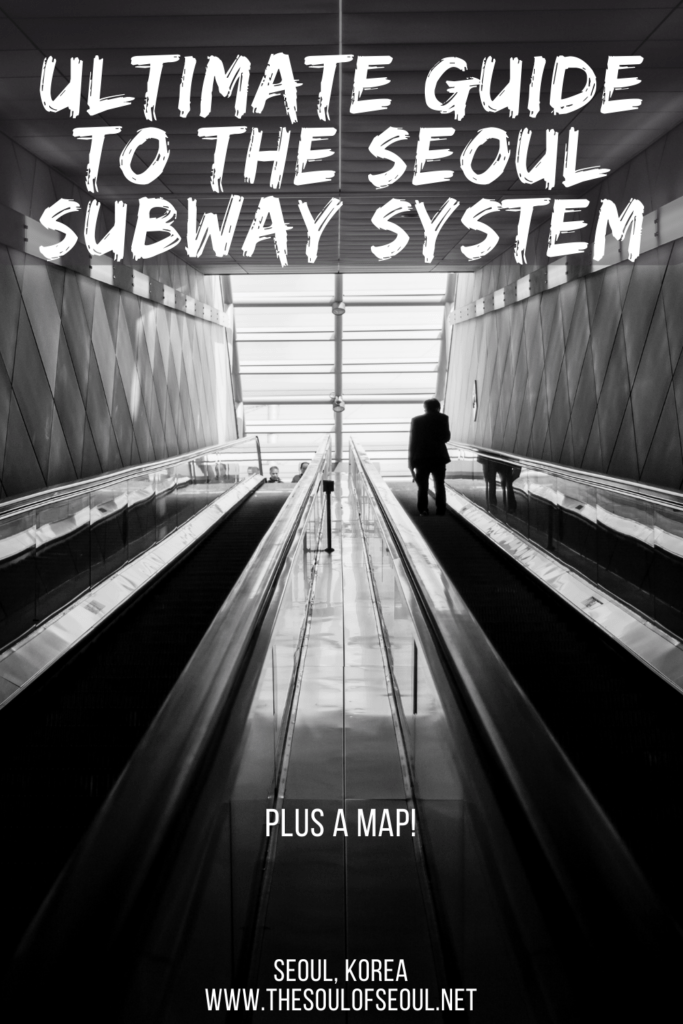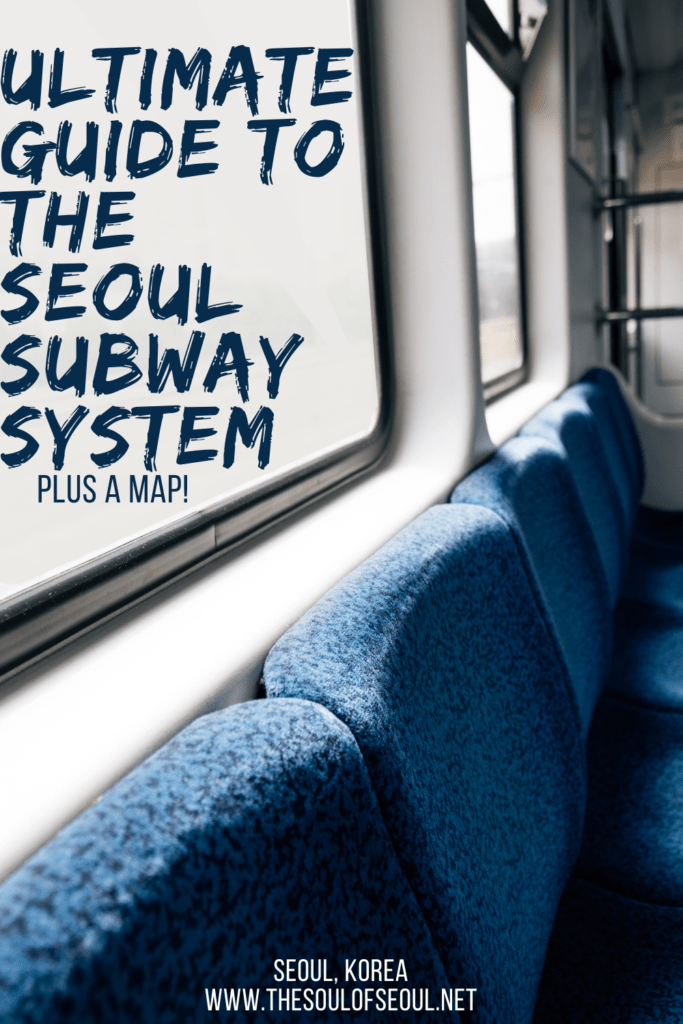Navigating Seoul with Ease: Your Ultimate Guide to the Seoul Subway System
Last Updated on November 12, 2024
Are you planning a visit to the bustling city of Seoul, South Korea? One of the most convenient and efficient ways to get around this vibrant metropolis is by using the Seoul Subway system. At first glance, the Seoul subway map can be pretty overwhelming but don’t let that sway you. Keep reading to learn everything you need to know about the Seoul Subway, from its history to using the T-money card for seamless travel.
From tips on how to get around Seoul, or information on the Korea subway system, we’ve got you covered. When it comes to getting around Seoul, the subway is definitely the best option, so get ready to ride!
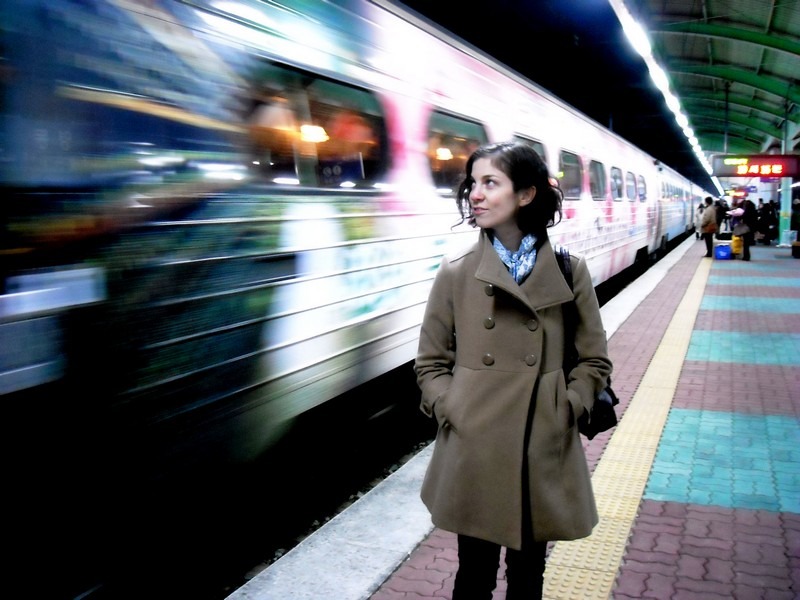
Get ready to learn everything you need to know about the Seoul Subway System and the look over the Seoul Subway Map so you’re ready to see it all when you arrive!
- A Brief History of the Seoul Subway System
- Exploring the Seoul Subway Network
- Seoul Subway Map – Your Handy Guide
- Seoul Subway System Basic Info
- Seoul Transport Cards
- How to Spot a Subway Station in Seoul
- How to Get Around Seoul with Ease
- Seoul Subway Etiquette
(This post contains affiliate links, which means I receive a certain percentage of a sale if you purchase after clicking at no cost to you. Thank you for your support.)
A Brief History of the Seoul Subway System
The Seoul Subway has a rich history that dates back to its inauguration in 1974, making it one of the oldest and most extensive metro systems in the world. Over the years, the system has seen remarkable expansion and development, serving as a lifeline for both locals and tourists.
With an efficient and well-maintained network, you can explore every nook and cranny of this sprawling city with ease. You can even get out of the city of Seoul and head into nearby cities like Incheon, even reaching the west coast all on the Seoul subway system.
The Seoul Metro has increased from just 4 lines and 106 stations in the 1980s to 9 lines and 338 stations in the 2000s and currently sits at 23 lines and 624 stations. Don’t let this information overwhelm you though. It just means you can get everywhere via the Seoul Subway System!
The Seoul Subway System is one of the best transit systems in the world and while it might look complicated, it’s not once you take a good look at the map and start understanding the names.
Exploring the Seoul Subway Network
The Seoul Subway system consists of an extensive network of lines, making it incredibly easy to navigate the city… well I say easy, but that’s if you don’t get on the subway going the wrong direction (If you get on the green line going the wrong way, don’t worry. Everyone does it at least once).

There are currently 23 lines, color-coded for your convenience on Seoul Subway maps that you’ll see. The extensive coverage ensures you can reach almost every corner of Seoul quickly and efficiently.
Each line has its unique character, connecting different neighborhoods and attractions, though most tourists will likely stick to the central loop, or the green line and a few others including:
- Line 1 (Blue Line): The oldest line, known as the “Main Line”, runs through the heart of the city from west to east stopping by touristy areas like Seoul Station, Noryangjin Fish Market and out to Incheon China Town, making it a convenient choice for tourists.
- Line 2 (Green Line): Often called the “Circle Line” as it forms a loop around central Seoul, connecting major attractions like Gangnam, Myeongdong, Dongdaemun Design Plaza, and Hongdae as well as trendy neighborhoods like Seongsu and Sindang.
- Line 6 (Brown Line): This line connects you to Itaewon and Hannam-dong, hidden gems to most tourists like World Cup Park and Eunpyeong-gu, as well as Mangwon.
- Line 9 (Gold Line): For easy access to Olympic Park, Lotte World, and Yeouido.
- Airport Railroad: Most likely the first part of the subway system that you’ll use is the Airport Railroad line which connects Incheon International Airport to Seoul for convenience and efficient access.
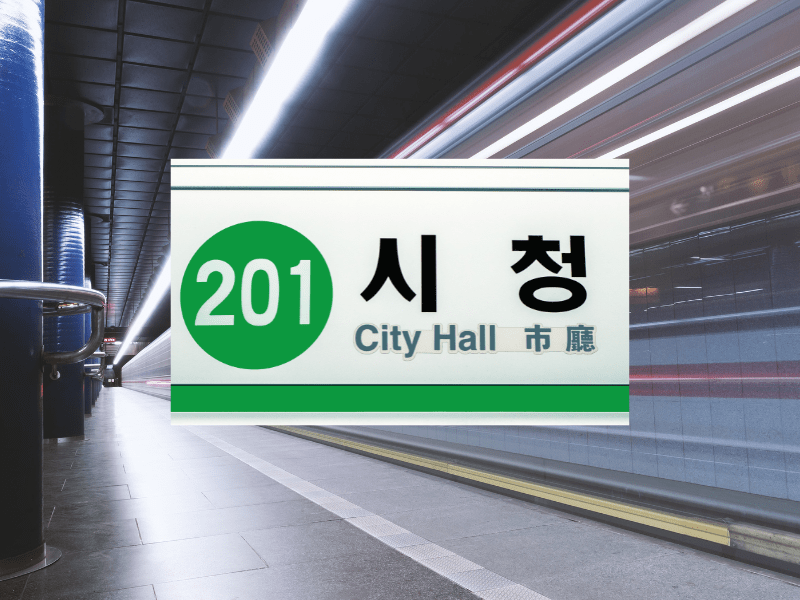
Interesting fact: The Seoul Subway system is known for its impressive length. If you were to lay out all its tracks in a straight line, they would extend over 700 kilometers! That’s longer than the distance from Seoul to Busan, South Korea’s second-largest city.
Seoul Subway Map – Your Handy Guide
To make your Seoul adventure even more enjoyable, you’ll want to get your hands on a Seoul subway map. You can find these at subway stations, tourist information centers, or even download them to your smartphone through various apps or the official Seoul Metro website. A physical map can be particularly helpful for tourists who prefer a tangible reference point. The map displays all the lines and stations, along with their respective transfer points.
Map of Seoul Subway in English
This is the Seoul Subway map that you will likely see on most websites and resources and the one I’ve been using since coming to Korea in 2006, however, in 2023, an updated map was released which you can find below.
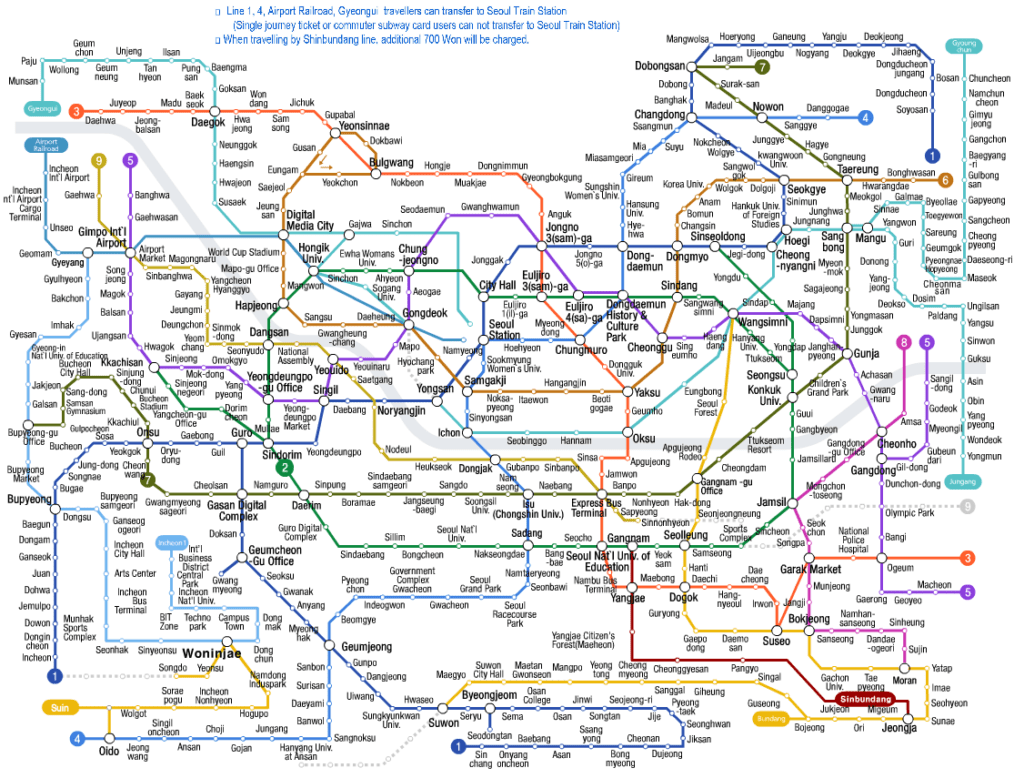
New Map of Seoul Subway in English
In 2023, the Seoul Metropolitan Government announced a redesign of the Seoul Metro map for the first time in 40 years. The new redesign takes into account the international ‘octolinear’ standard for easier recognition of transfer stations, and geographical denotations, while keeping the varying colors and patterns to distinguish lines.
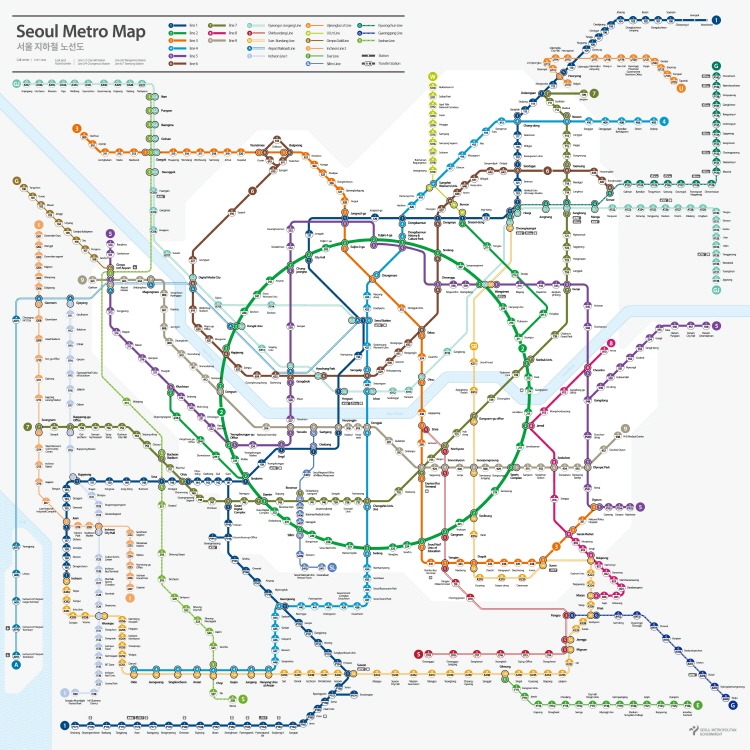
The improved design underwent eye-tracking experiments among Korean citizens in their 20s and 30s and international visitors, where results showed a reduction of around 55% in the amount of time to locate a station, and around a 69% reduction in the amount of time to locate a transfer station. In particular, the amount of time it took international participants to locate a station was 21.5% better than that of Korean citizens, demonstrating that the improved map will be very useful for first-time visitors to Seoul.
Source: Seoul Metropolitan Government
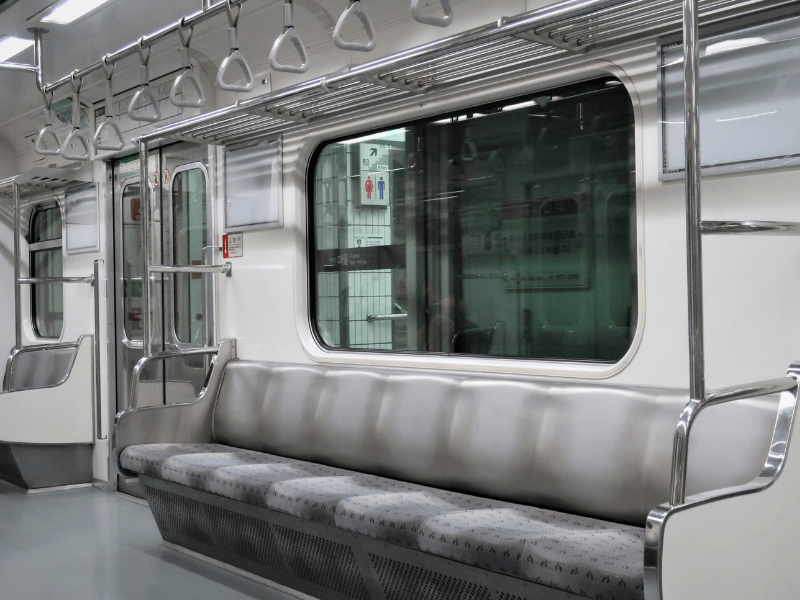
Seoul Subway System Basic Info
Hours: The Seoul Subway System is open from 5:30am until 1:00am, but make sure to check the line and the last train that you’re looking to use. There are some lines that stop earlier. Rush hour is between 4:30pm and 8:00pm and the subway can be extremely crowded.
Amenities: Breastfeeding rooms, bathrooms, elevators/wheelchair lifts, lockers
Website: Seoul Metro
Seoul Transport Cards
There are a number of cards that will work on the Seoul Subway System, deciding which one to get is just a matter of deciding what you’ll be doing and what perks you want to take advantage of.
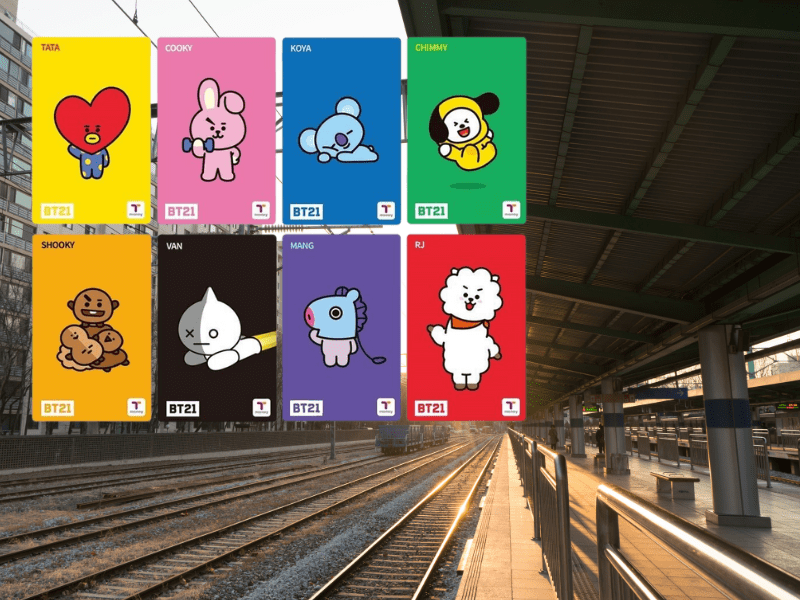
T-Money Card
To make your subway travels even more convenient, but also cheaper, we recommend getting a T-money card. This rechargeable smart card is the basic travel card that all Koreans use to get to and fro and not only allows you to ride the subway but can also be used on buses and taxis. You can purchase these cards at subway station vending machines or convenience stores.
- Note that if you have children, you should purchase the T-Money card in a convenience store and let them know the age of your child so they can register the card as a child’s card and you can get the child discounted fares.
- Convenience Stores: You can purchase a T-Money card at GS25, CU, 7-Eleven, MINISTOP, Story Way, Emart24, 365 PLUS
Prebook and buy a T-Money card to pick up at the airport or to have delivered to you here:
- Klook T-Money Card + SIM Card: Choose from 3 budget-friendly options: T-money and W5,000, or T-money and W10,000. You can pick up the card at Incheon International Airport or at Gimpo International Airport.
Special Designs: There are a variety of design options when it comes to T-Money cards. The most basic ones are cheaper when you go to buy them up at any convenience store, but there are cuter designed ones, which many tourists opt for as they want to keep them as souvenirs are available too.

Using the T-money Card: To use the T-money card, simply tap it on the card reader when entering and exiting the subway gates. The fare is automatically deducted based on your journey’s distance.
Recharge as You Go: T-money cards are reloadable, so you can top up your balance at any time. This eliminates the need to carry cash for your subway trips. You can recharge your card at ticketing kiosks in subway stations which provide information in a number of languages including English, Korean, Chinese, and Japanese and you can top up cards at convenience stores but note that you need to have cash to top up.
Also, if at the end of your trip, there is still money on your card, you can use them in convenience stores to purchase food, drinks, etc. Just look at the back of your card for the names of the convenience stores that you can visit.
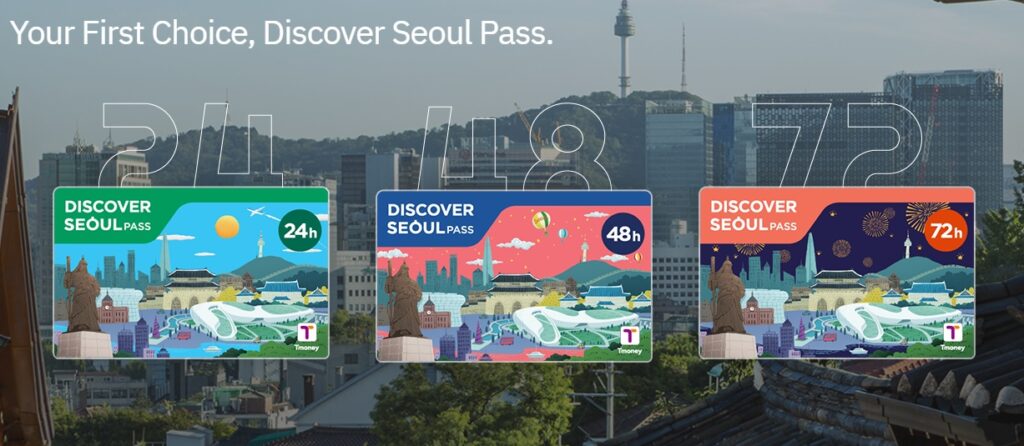
Discover Seoul Pass
Created by the Seoul Tourism Organization and the Seoul Metropolitan Government, their goal was to give foreign tourists access to the most prominent landmarks in the capital of Korea. The Discover Seoul Pass functions as your admission ticket and transportation card as you go from place to place and acts as a discount card too. The Discover Seoul Pass allows access to some of Seoul’s biggest landmarks and a selection of historical, cultural and Hallyu attractions.
This card can be very useful for tourists that are looking to see a lot in a short period of time. In order to make the Discover Seoul Pass the most effective for you, it does take some planning. Check out these Discover Seoul Pass Itineraries to maximize your time with the card.
One bonus of the card though, is that it also functions as a T-Money card even after you’ve used it for admissions to various sights and it also provides discounts while shopping so it’s a great option for tourists looking to enjoy their stay and get discounts.
Prebook and buy a T-Money card to pick up at the airport or to have delivered to you here:
- Klook Discover Seoul Pass: You can book a 24 hour, 48 hour, or 72 hour Discover Seoul Pass on Klook and you can pick it up at the Incheon International Airport.
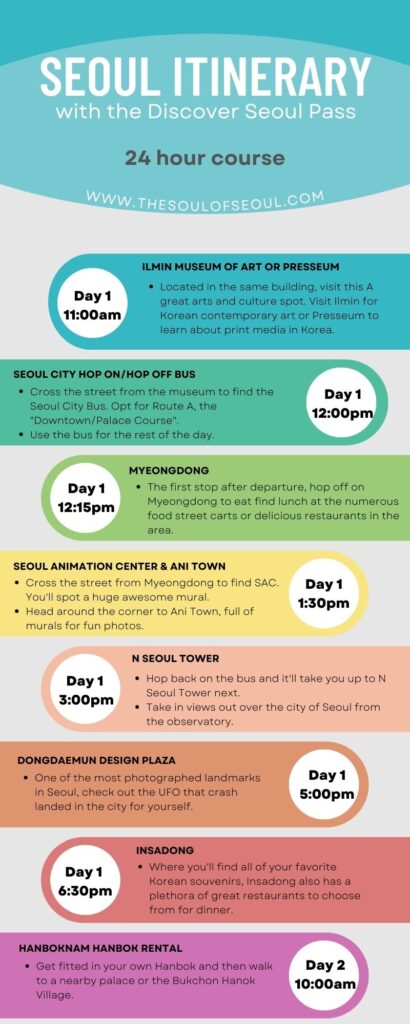
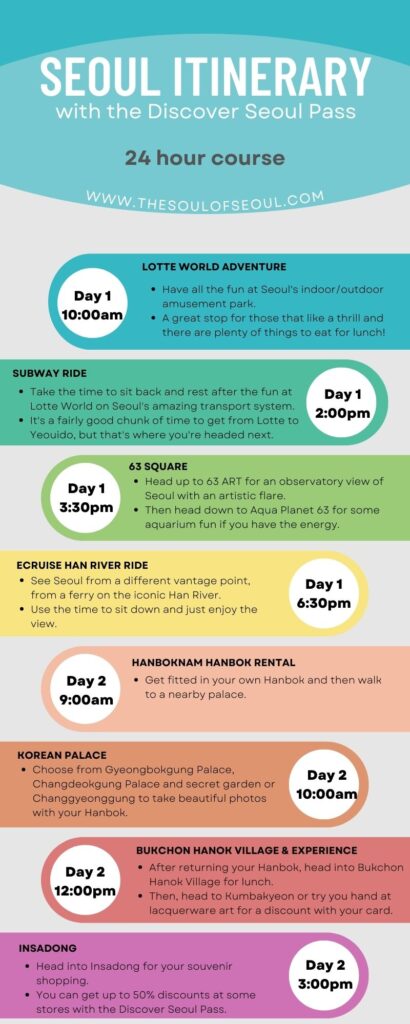
How to Spot a Subway Station in Seoul
You’ll spot entrances to subway stations in Seoul along sidewalks via sign posts with yellow train logo. Usually the staircases that lead down underground are also covered. There are some entrances that appear to be apart of a nearby building, but head down and you’ll see it’s the subway.
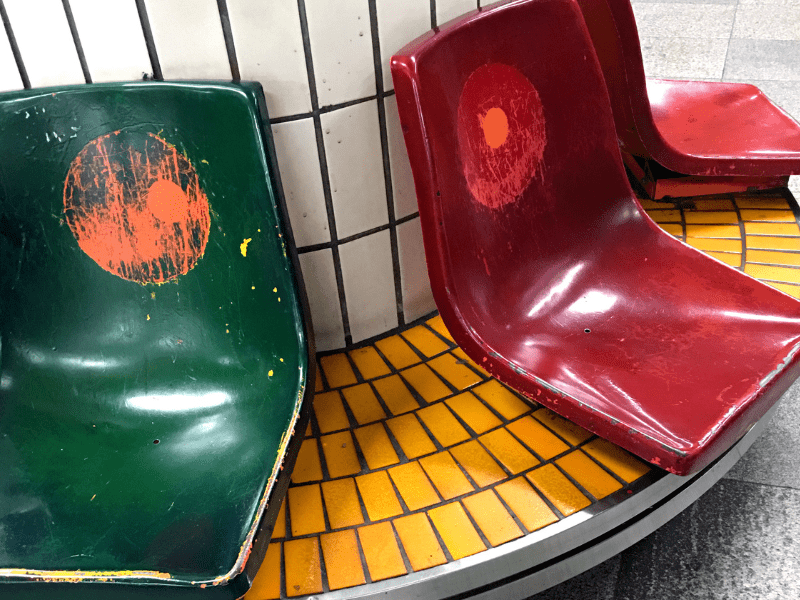
How to Get Around Seoul with Ease
Navigating the Seoul Subway is quite straightforward, as the system is known for its user-friendliness. Here are some tips to help you make the most of your subway experience:
- Reading Maps: There are maps available to pick up in the subway stations, also on the walls of subway stations, but if you want to figure out the fastest route from here to there, you should use the Korean navigation apps like KakaoMap or Naver Map. While a lot of travelers might try to use Google Maps, it just doesn’t cut it in Korea and can cause more confusion. Even if you don’t speak or read Korean, these navigation apps have an English option so just switch it in the settings if you need.
- Transfers: The Seoul Subway system is designed for easy transfers between different lines. Most major stations have transfer points, making it seamless to switch from one line to another.
- Rush Hour: Avoid traveling during rush hours (typically 7:00am ~ 9:00am and 6:00pm ~ 8:00pm) to have a more comfortable experience.
Seoul Subway Etiquette
As someone who has taken a number of tourists around in Seoul, I think it’s important to highlight the Seoul Subway etiquette a bit as it might be different from other countries where you’ve ridden on public transportation.
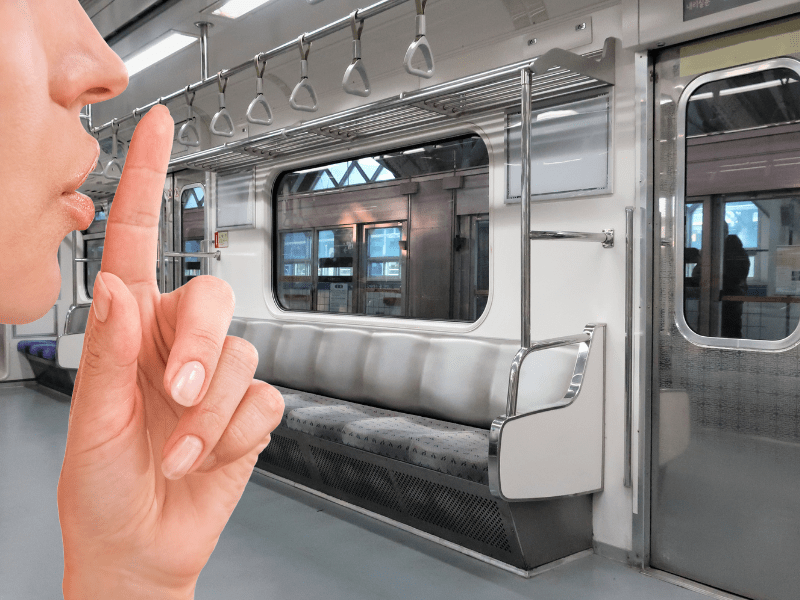
- Wait for passengers to exit before entering the train car. You should stand on the side of the doorways so people can exit. (To be honest, you’ll find that not all Koreans abide by this in their rush, but it’s good practice and just makes sense.)
- Do not sit on seats designated for the disabled, pregnant women, or senior citizens. Usually at the ends of the train cars are where the disabled and elderly sit and there are bright pink seats in the central areas of the car that are designated for pregnant women.
- When going in and out of the station and down to the platform, you might notice that Koreans use the right side of escalators for standing and riding while the left side is for people walking up and down. There are actually signs that let people know they should just stand, but as mentioned above, Koreans are often in a rush in Seoul so you may want to step to the right so you don’t annoy anyone.
- Americans are often lambasted for talking loudly on the subways. Koreans prefer the subway cars and buses to be quiet. Most people will stick headphones in and listen to music or shows while they ride and won’t even have conversations.
Whether you’re an intrepid explorer looking to uncover Seoul’s hidden gems or a traveler eager to visit the city’s iconic landmarks, the Seoul Subway system is your reliable companion. Offering a convenient, efficient, and cost-effective way to explore Seoul, don’t forget to grab a Seoul subway map, consider purchasing a T-money card for hassle-free travel, and follow our tips to navigate Seoul with ease.
Did you like this post? Pin IT!
